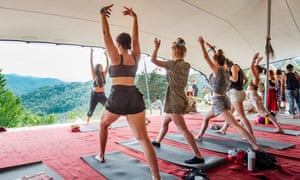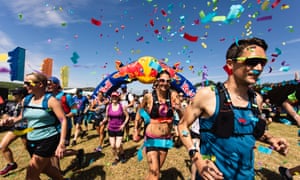
Festivals are traditionally a mecca for music and hedonism, but a new focus on wellbeing is emerging as young people swap drink and drugs for mindfulness and yoga.
In recent years there has been an explosion in festivals that have put wellbeing at their heart. This weekend Fearne Cotton will host Happy Place, her first summer festival which is dedicated to “simple joy” and helping attendees “unlock that inner happiness”.
Other festivals are merging music and wellness, such as RunFestRun in Wiltshire, Love Trails in Gower peninsula, Meadows in the Mountains in Bulgaria, and Soul Circus, a wellness festival with a focus on yoga in the Cotswolds.
It’s a movement being reflected in goliath festivals such as Glastonbury, which introduced a wellness area this year. Latitude, an annual music festival in Suffolk, also made a big push on wellbeing offering yoga workshops, art installations, and swimming this summer.
“Glastonbury had the Humble Well area this year and they also did lots of spiritual and wellbeing stuff, so things such as the Wisdom Keepers, which are 12 indigenous leaders and spiritual elders who had come across on a pilgrimage. They did workshops on the misuse of ayahuasca and how to look after your spiritual as well as mental health,” according to Alex Holbrook, founder of spiritual wellbeing platform Otherness.

Holbrook puts the rise in festivals taking account of wellness down to the soaring wellbeing movement. “Ten years ago meditation and yoga were not mainstream but now there are dedicated areas for them at Glastonbury, which is amazing. When I was at Glastonbury this year there were a few people who I saw jogging on the Saturday morning. That is dedication … Culturally, we are becoming more wellbeing-focused,” she said.
Another music festival embracing wellness is Meadows in the Mountains, set in the Rhodope mountains near Bulgaria’s Greek border. It started out with 50 people attending, growing to 3,500 guests this summer in the event’s ninth year. It offers yoga, meditation and even cacao ceremonies, which is a type of shamanic healing.
Elena Byers, the curator of Mesa, the wellbeing space at Meadows in the Mountains, said there had been a rise in music festivals adding a wellness element. “Absolutely. I find as a teacher as well you’ve got more and more people who come to festivals now than ever before and they are much more curious and open-minded about things like wellbeing … They feel more inclined to try stuff that they haven’t before.”
She said the diversity of what was on offer had also changed. “It used to be that there were just yoga classes but now you’ve got more interesting things, like you’ve got chanting circles and cacao ceremonies or breath work.”
It comes as young people turn their backs on alcohol. Research, published in the journal BMC Public Health, found more than 25% of young people classed themselves as “non-drinkers”. Those behind the study said abstaining from alcohol was becoming “more mainstream” among people aged 16 to 24 after the analysis showed a rise in the proportion of non-drinkers.
“The sober movement is also a huge part of what is happening with festivals … It’s becoming more socially acceptable not to drink so people at festivals don’t have the same peer pressure,” said Holbrook.

Theo Larn-Jones, the co-founder and director of Love Trails, which started in 2016, agrees. “When we started what we were doing was quite unique. We were the first festival to combine running and music. But we have noticed that we were on the leading edge of that trend and now other festivals are picking up on that.”
“Basically, the crux of it is that it is tapping into the desire from, especially younger people – so those in their 20s and 30s – to live fuller and healthier lives and feel good. I am part of that group: we still want to go to festivals and want to party but don’t necessarily want to get off our faces and get drunk in the process … It’s like the runners’ high, that endorphin hit from a run is replacing other kinds of highs you might get at festivals,” Larn-Jones said.
He said that 30 people came to the 2016 event, whereas this year there were nearly 2,000. “It has grown really quickly,” he said.
Byers said the trend brought a new element to festivals and could leave a positive impact. “These practices make you feel good … We can see the tangible effects that they have had, not just in terms of our mental wellbeing and our ability to be calm and connect and recalibrate in a fast-paced technological world. But they also help us reconnect with people and I think ultimately that’s why people come to them and I think often when they find those things they tend not to leave. They love it.”
[“source=theguardian”]

